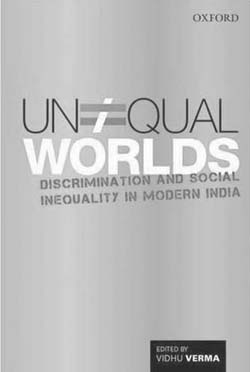Reading Unequal Worlds by Vidhu Verma is like reading an epistemological ‘post-mortem’ of the societal context which prompted Rohith Vemula to commit suicide. The book unfolds a number of factors which put Dalits and minorities (read Muslims) to ‘social death’ in their everyday life. Discrimination has been direct, indirect, institutional or structural. It can be seen in institutional biases, social closure to maximize rewards by restricting access to resources and opportunities to a limited circle of the eligible (p. 26); through ‘unruly practices’ (gaps between rules and their implementation). The volume deals with various dimensions of discrimination and is divided into four parts: theoretical perspectives; comparative perspectives, structural discrimination and legislation and newer forms of discrimination. But it has one message, that Brahmanical hegemony continues in the state, market and civil society which reduces Dalits and minorities (includes sexual minority) to a lesser human.
Unequal Worlds deals with questions such as: a) Are caste and class important in their own right or are they merely epiphenomenal to the patterns that effects outcomes, for example, globalization? b) How do initially symmetric or uniform structures of caste relations give rise to highly complex functional structures when they encounter modern processes of production where caste becomes something else? c) How does the anti-discrimination principle, as one binding on the state alone, impose higher obligations on state institutions, when compared to private ones, so that we can see problems in housing, membership organizations, temple entry, and matrimonial alliances still as very valid? d) How and in what context are forms of discrimination likely to be salient in Indian society in the coming decade?. The methodological inquiry by this volume also makes it an important read.
Technically, this volume is an attempt to examine the discrimination question in the light of new dimensions of social inequality in the neo-liberal era. It has focused more on horizontal inequalities arising out of differences due to the membership of social groups reflecting attributes of sex, caste, and the religious or ethnic origin of the citizen. The editor has argued that the globalization process has a variable impact on different sectors of the economy, leading to uneven and imbalanced growth under which the process of social exclusion of groups has been intensified. The claim is directly in contrast with the understanding of those who advocate economic reform as panacea. There are groups of individuals within the Dalit community as well who think that ‘Market can beat Manu’.
There are promotors of Dalit capitalism in the form of the Indian Chamber of Commerce and Industry (DICCI) whose chairman Milind Kamble asserts that ‘caste and capital cannot coexist’. ‘Capitalism dismantles rural societies and feudalism. Capitalism dismantles traditions and traditional cultures. Capitalism produces urban societies, democracy and modernity. India’s caste system thrived and survived on agrarianism and traditional culture. Caste is losing its grip over the Dalits because India is industrializing, urbanizing and modernizing. Dalit capitalism will accelerate that process and will accord a human face to Indian capitalism. Caste and capital can’t coexist. One has to give way to the other.’

